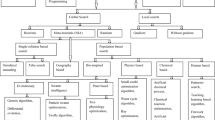Abstract
The selection of optimal machining parameters plays an important part in computer-aided manufacturing. The optimisation of machining parameters is still the subject of many studies. Genetic algorithm (GA) and simulated annealing (SA) have been applied to many difficult combinatorial optimisation problems with certain strengths and weaknesses. In this paper, genetic simulated annealing (GSA), which is a hybrid of GA and SA, is used to determine optimal machining parameters for milling operations. For comparison, basic GA is also chosen as another optimisation method. An application example that has previously been solved using geometric programming (GP) method is presented. The results indicate that GSA is more efficient than GA and GP in the application of optimisation.
Similar content being viewed by others
References
Sönmez AI, Baykasoglu A, Dereli T, Filiz IH. (1999) Dynamic optimization of multipass milling operations via geometric Programming. Int J Mach Tools Manuf 39(2):297–320
Gray P, Hart W, Painton L, Phillips C, Trahan M, Wagner J (2002) A survey of global optimization methods. http://www.cs.sandia.gov /opt/survey/, cited June 2002
Duffuaa SO, Shuaib AN, Alam M (1993) Evaluation of optimization methods for machining economics models. Comput Oper Res 20(2):227–237
Tolouei-Rad M, Bidhendi IM (1997) On the optimization of machining parameters for milling operations. Int J Mach Tools Manuf 37(1):1–16
Wang J, Armarego EJA (2001) Computer-aided optimization of multiple constraint single pass face milling operations. Mach Sci Technol 5(1):77–99
Wang J (1998) Computer-aided economic optimization of end-milling operations. Int J Prod Econ 54(3):307–320
Wang J, Kuriyagawa T, Wei XP, Guo DM (2002) Optimization of cutting conditions for single pass turning operations using a deterministic approach. Int J Mach Tools Manuf 42(9):1023–1033
Armarego EJA, Smith AJR, Wang J (1993) Constrained optimization strategies and CAM software for single-pass peripheral milling. Int J Prod Res 31(9):2139–2160
Kilic SE, Cogun C, Sen DT (1993) A computer-aided graphical technique for the optimization of machining conditions. Comput Ind 22(3):319–326
Kee KP (1996) Development of constrained optimization analyses and strategies for multi-pass rough turning operations. Int J Mach Tools Manuf 36(1):115–127
Kayacan MC, Filiz IH, Sönmez AI, Baykasolu A, Dereli T (1996) OPPS-ROT: an optimized process planning system for rotational parts. Comput Ind 32(2):181–195
Agapiou JS (1992) Optimization of machining operations based on a combined criterion, part 2: multipass operations. J Eng Ind Trans ASME 114(4)::508–513
Jang DY (1992) A unified optimization model of a machining process for specified conditions of machined surface and process performance. Int J Prod Res 30(3):647–663
Wang J (1993) Multiple-objective optimization of machining operations based on neural net-works. Int J Adv Manuf Technol 8(4):235–243
Ermer DS (1971) Optimization of the constrained machining economics problem by geometric programming. J Eng Ind 93(4):1067–1072
Wang J (1993) Constrained optimization of rough peripheral and end milling operations. PhD Thesis, University of Melbourne, Australia
Shin YC, Joo YS (1992) Optimization of machining conditions with practical constraints. Int J Prod Res 30(12):2907–2919
Petropoulos PG (1973) Optimal selection of machining rate variable by geometric programming. Int J Prod Res 11(4):305–314
Jha NK (1990) A discrete data base multiple objective optimization of milling operation through geometric programming. J Eng Ind 112(4):368–374
Dereli T, Filiz IH, Baykasoglu A (2001) Optimizing cutting parameters in process planning of prismatic parts by using genetic algorithms. Int J Prod Res 39(15):3303–3328
Shunmugam MS, Bhaskara Reddy SV, Narendran TT (2000) Selection of optimal conditions in multi-pass face-milling using a genetic Algorithm. Int J Mach Tools Manuf 40(3):401–414
Liu YM, Wang CJ (1999) Modified genetic algorithm based optimization of milling parameters. Int J Adv Manuf Technol 15(11):796–799
Shroff P, Watson DW, Flann NS, Freund RF (2002) Genetic simulated annealing for scheduling data-dependent tasks in heterogeneous environments. http://www.cs.ucsd. edu/users/berman/hcw.papers /hcwpc13_watson.ps, cited June 2002
Chen H, Flann NS (1994) Parallel simulated annealing and genetic algorithms: a space of hybrid methods. Proceedings of International Conference on Evolutionary Computation–PPSN III, pp428–438
Michalewicz Z (1996) Genetic algorithms+data structures=evolution Programs. Springer, Berlin Heidelberg New York
Author information
Authors and Affiliations
Corresponding author
Rights and permissions
About this article
Cite this article
Wang, Z., Wong, Y. & Rahman, M. Optimisation of multi-pass milling using genetic algorithm and genetic simulated annealing. Int J Adv Manuf Technol 24, 727–732 (2004). https://doi.org/10.1007/s00170-003-1789-5
Received:
Accepted:
Published:
Issue Date:
DOI: https://doi.org/10.1007/s00170-003-1789-5




